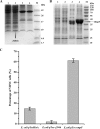New Insights into the Formation of Viable but Nonculturable Escherichia coli O157:H7 Induced by High-Pressure CO2
- PMID: 27578754
- PMCID: PMC4999544
- DOI: 10.1128/mBio.00961-16
New Insights into the Formation of Viable but Nonculturable Escherichia coli O157:H7 Induced by High-Pressure CO2
Abstract
The formation of viable but nonculturable (VBNC) Escherichia coli O157:H7 induced by high-pressure CO2 (HPCD) was investigated using RNA sequencing (RNA-Seq) transcriptomics and isobaric tag for relative and absolute quantitation (iTRAQ) proteomic methods. The analyses revealed that 97 genes and 56 proteins were significantly changed upon VBNC state entry. Genes and proteins related to membrane transport, central metabolisms, DNA replication, and cell division were mainly downregulated in the VBNC cells. This caused low metabolic activity concurrently with a division arrest in cells, which may be related to VBNC state formation. Cell division repression and outer membrane overexpression were confirmed to be involved in VBNC state formation by homologous expression of z2046 coding for transcriptional repressor and ompF encoding outer membrane protein F. Upon VBNC state entry, pyruvate catabolism in the cells shifted from the tricarboxylic acid (TCA) cycle toward the fermentative route; this led to a low level of ATP. Combating the low energy supply, ATP production in the VBNC cells was compensated by the degradation of l-serine and l-threonine, the increased AMP generation, and the enhanced electron transfer. Furthermore, tolerance of the cells with respect to HPCD-induced acid, oxidation, and high CO2 stresses was enhanced by promoting the production of ammonia and NADPH and by reducing CO2 production during VBNC state formation. Most genes and proteins related to pathogenicity were downregulated in the VBNC cells. This would decrease the cell pathogenicity, which was confirmed by adhesion assays. In conclusion, the decreased metabolic activity, repressed cell division, and enhanced survival ability in E. coli O157:H7 might cause HPCD-induced VBNC state formation.
Importance: Escherichia coli O157:H7 has been implicated in large foodborne outbreaks worldwide. It has been reported that the presence of as few as 10 cells in food could cause illness. However, the presence of only 0.73 to 1.5 culturable E. coli O157:H7 cells in salted salmon roe caused infection in Japan. Investigators found that E. coli O157:H7 in the viable but nonculturable (VBNC) state was the source of the outbreak. So far, formation mechanisms of VBNC state are not well known. In a previous study, we demonstrated that high-pressure CO2 (HPCD) could induce the transition of E. coli O157:H7 into the VBNC state. In this study, we used RNA-Seq transcriptomic analysis combined with the iTRAQ proteomic method to investigate the formation of VBNC E. coli O157:H7 induced by HPCD treatment. Finally, we proposed a putative formation mechanism of the VBNC cells induced by HPCD, which may provide a theoretical foundation for controlling the VBNC state entry induced by HPCD treatment.
Copyright © 2016 Zhao et al.
Figures







Similar articles
-
Induction of viable but nonculturable Escherichia coli O157:H7 by high pressure CO2 and its characteristics.PLoS One. 2013 Apr 23;8(4):e62388. doi: 10.1371/journal.pone.0062388. Print 2013. PLoS One. 2013. PMID: 23626816 Free PMC article.
-
Effect of preliminary stresses on the induction of viable but non-culturable Escherichia coli O157:H7 NCTC 12900 and Staphylococcus aureus ATCC 6538.Food Res Int. 2023 May;167:112710. doi: 10.1016/j.foodres.2023.112710. Epub 2023 Mar 17. Food Res Int. 2023. PMID: 37087272
-
Acid shock protein Asr induces protein aggregation to promote E. coli O157:H7 entering viable but non-culturable state under high pressure carbon dioxide stress.Food Microbiol. 2023 Feb;109:104136. doi: 10.1016/j.fm.2022.104136. Epub 2022 Sep 14. Food Microbiol. 2023. PMID: 36309439
-
Significance of Viable but Nonculturable Escherichia coli: Induction, Detection, and Control.J Microbiol Biotechnol. 2017 Mar 28;27(3):417-428. doi: 10.4014/jmb.1609.09063. J Microbiol Biotechnol. 2017. PMID: 27974738 Review.
-
Molecular Profiling: Catecholamine Modulation of Gene Expression in Escherichia coli O157:H7 and Salmonella enterica Serovar Typhimurium.Adv Exp Med Biol. 2016;874:167-82. doi: 10.1007/978-3-319-20215-0_7. Adv Exp Med Biol. 2016. PMID: 26589218 Review.
Cited by
-
Transcriptomic Analysis of Viable but Non-Culturable Escherichia coli O157:H7 Formation Induced by Low Temperature.Microorganisms. 2019 Nov 30;7(12):634. doi: 10.3390/microorganisms7120634. Microorganisms. 2019. PMID: 31801285 Free PMC article.
-
Essential oils and their active components applied as: free, encapsulated and in hurdle technology to fight microbial contaminations. A review.Heliyon. 2022 Dec 20;8(12):e12472. doi: 10.1016/j.heliyon.2022.e12472. eCollection 2022 Dec. Heliyon. 2022. PMID: 36590515 Free PMC article. Review.
-
Chicken Skin Decontamination of Thermotolerant Campylobacter spp. and Hygiene Indicator Escherichia coli Assessed by Viability Real-Time PCR.Pathogens. 2022 Jun 18;11(6):706. doi: 10.3390/pathogens11060706. Pathogens. 2022. PMID: 35745559 Free PMC article.
-
Insights Into Mechanisms of Antimicrobial Photodynamic Action Toward Biofilms Using Phenalen-1-One Derivatives as Photosensitizers.Front Microbiol. 2020 Oct 30;11:589364. doi: 10.3389/fmicb.2020.589364. eCollection 2020. Front Microbiol. 2020. PMID: 33193252 Free PMC article.
-
The Association of Cell Division Regulated by DicC With the Formation of Viable but Non-culturable Escherichia coli O157:H7.Front Microbiol. 2019 Dec 10;10:2850. doi: 10.3389/fmicb.2019.02850. eCollection 2019. Front Microbiol. 2019. PMID: 31921032 Free PMC article.
References
-
- Oliver JD. 2000. The viable but nonculturable state and cellular resuscitation, p 723–730. In Bell CR, Brylinsky M, Johnson-Green P (ed), Microbial biosystems: new frontiers. Atlantic Canada Society for Microbial Ecology, Halifax, Canada.
Publication types
MeSH terms
Substances
LinkOut - more resources
Full Text Sources
Other Literature Sources
Molecular Biology Databases
